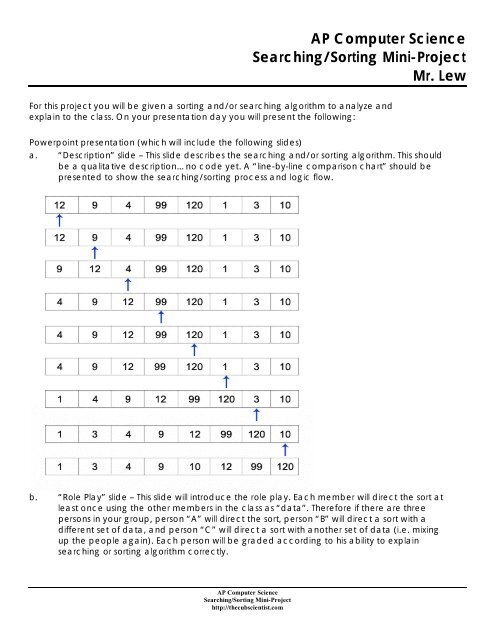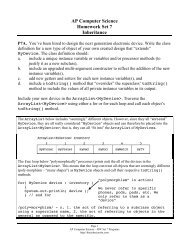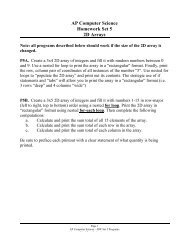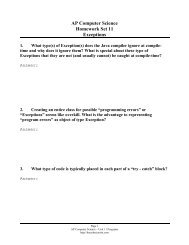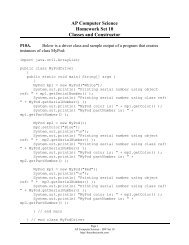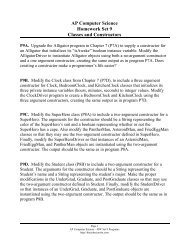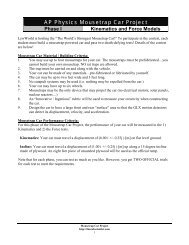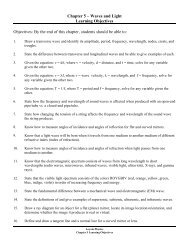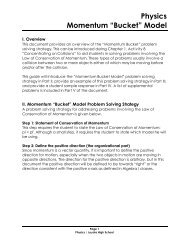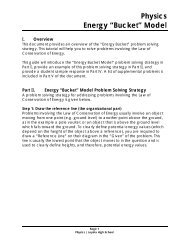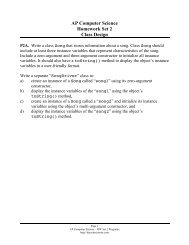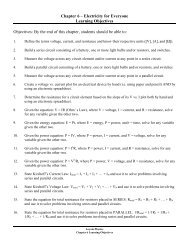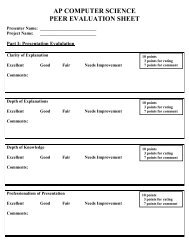Sorting and Searching Mini-Project - thecubscientist.com
Sorting and Searching Mini-Project - thecubscientist.com
Sorting and Searching Mini-Project - thecubscientist.com
Create successful ePaper yourself
Turn your PDF publications into a flip-book with our unique Google optimized e-Paper software.
AP Computer Science<br />
<strong>Searching</strong>/<strong>Sorting</strong> <strong>Mini</strong>-<strong>Project</strong><br />
Mr. Lew<br />
For this project you will be given a sorting <strong>and</strong>/or searching algorithm to analyze <strong>and</strong><br />
explain to the class. On your presentation day you will present the following:<br />
Powerpoint presentation (which will include the following slides)<br />
a. “Description” slide – This slide describes the searching <strong>and</strong>/or sorting algorithm. This should<br />
be a qualitative description…no code yet. A “line-by-line <strong>com</strong>parison chart” should be<br />
presented to show the searching/sorting process <strong>and</strong> logic flow.<br />
b. “Role Play” slide – This slide will introduce the role play. Each member will direct the sort at<br />
least once using the other members in the class as “data”. Therefore if there are three<br />
persons in your group, person “A” will direct the sort, person “B” will direct a sort with a<br />
different set of data, <strong>and</strong> person “C” will direct a sort with another set of data (i.e. mixing<br />
up the people again). Each person will be graded according to his ability to explain<br />
searching or sorting algorithm correctly.<br />
AP Computer Science<br />
<strong>Searching</strong>/<strong>Sorting</strong> <strong>Mini</strong>-<strong>Project</strong><br />
http://<strong>thecubscientist</strong>.<strong>com</strong>
c. “Java code Demonstration” slide – Here you will demonstrate the searching <strong>and</strong>/or sorting<br />
algorithm in a small Java program that meets the following specifications:<br />
i. the program allows user to input the number of integers to sort (0 – Integer.MAX_VALUE).<br />
Use Math.r<strong>and</strong>om to generate integers.<br />
ii. the program prints the time elapsed for the search or sort algorithm to <strong>com</strong>plete its task.<br />
Use the provided Timer test program as your testbench.<br />
iii. students discuss the “best case scenario” set of data (no simulation needed)<br />
ii. students discuss the “worst case scenario” set of data (no simulation needed)<br />
iv. students discuss the code <strong>and</strong> how it corresponds to the algorithm demonstrated in the<br />
role play.<br />
d. “Execution Time” slide – This slide will show a graph of “Execution Time vs. Number of Array<br />
Elements”. A short discussion should follow that discusses the relationship between these<br />
two variables.<br />
e. “Advantages <strong>and</strong> disadvantages” slide – Here you discuss the advantages <strong>and</strong><br />
disadvantages of the searching <strong>and</strong>/or sorting algorithm (when you might WANT to use it,<br />
<strong>and</strong> when you might NOT want use it. IMPORTANT slide…spend some time on this!!<br />
f. “Memory issues” slide – discuss how much extra memory (if any) is needed in order to run<br />
your searching <strong>and</strong>/or sorting algorithm.<br />
AP Computer Science<br />
<strong>Searching</strong>/<strong>Sorting</strong> <strong>Mini</strong>-<strong>Project</strong><br />
http://<strong>thecubscientist</strong>.<strong>com</strong>


